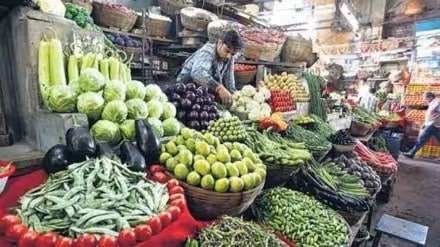After staying above the 6% mark for two consecutive months, India’s Consumer Price (CPI)- based inflation fell to a three-month low of 5.02% in September, according to data released by the National Statistical Office on Thursday. The sharper-than-expected decline in retail inflation occurred mainly on account of a sequential crash in prices of vegetables–particularly tomatoes–and cooking gas (LPG), but the base effect also helped.
The retail inflation stood at 6.83% in August 2023, while it was 7.41% in September last year.
Core inflation, which excludes volatile components of food and fuel, declined to a 42-month low of 4.5% in September, indicating broad-based easing of underlying price pressures.
With the September print, CPI inflation averaged 6.4% in July-September quarter, in line with the Reserve Bank of India’s projection, which might prompt the central bank to remain on pause in the rate hiking cycle through FY24.
A spike in global crude oil prices that began in mid-September did not impact the inflation print adversely because retail auto fuel prices remained unchanged. The Israel-Hamas war has, however, raised fresh concerns about global commodity prices.
The vegetables index, which carries a weight of 6% in the CPI basket, plunged 15.8% month-on-month in September, the steepest pace in 33 months. The tomatoes’ index within vegetables plummeted 64.9% on month, at the highest rate in at least nine years. The prices of tomatoes that skyrocketed in July on account of supply disruptions corrected sharply in September with the advent of fresh arrivals in the market.
The fuel and light index dropped 3.9% sequentially reflecting the cut in prices of LPG that occurred in the last week of August. On August 29, the Centre had cut the price of LPG by Rs 200 per 14.2-kg cylinder. The index carries a weight of 6.8% in the CPI basket.
The cooling of tomato prices helped the Consumer Food Price Index (CFPI)-based inflation to ebb to a 3-month low of 6.56% in September, but the moderation was arrested as prices of other key food items rose sequentially.
The inflation rate of cereals eased to 10.95% from 11.85% in August, and that of vegetables dropped to 3.39% from 26.14%. Inflation of pulses, however, spiked to 16.38% in September from 13.04% the previous month.
“The decline in headline CPI has been partly negated by a surge in pulse prices. Other than pulse, prices of cereals and spices continue to remain to the boil,” said Kunal Kundu, India economist, Societe Generale.
The index of pulses and products rose 4.1% on month in September–which was the fastest in 41 months. Pulses prices have remained elevated in the past few months owing to a shortfall in production and sluggish imports. Traders say the price of the commodity may remain high in the near term as well.
Cereals and products index was up 1.2% sequentially during the month as well, keeping the inflation of the sub-group in double digits for the 13th straight month. Both cereals and pulses subgroups constitute about 13% of the CPI basket.
“Upward pressure persists in several food items with 50% of the food and beverages subcomponents by weight, seeing 6%+ inflation in September. The inflation pressure in cereals, pulses, spices and milk has been persistent,” said Gaura Sen Gupta, economist, IDFC FIRST Bank.
“The key risk to inflation outlook remains from food inflation due to the uneven monsoon performance and low reservoir levels,” she said.
Bank of Baroda Chief Economist Madan Sabnavis said that the final outcome of the kharif harvest will have a bearing on inflation from hereon.
Besides housing, the other three components of core–miscellaneous, pan, tobacco & intoxicants, and clothing & footwear saw sequential increase in prices.
The housing index fell 0.1% month-on-month in September, however some experts have called it an aberration. “The sequential fall in housing index in latest data is an aberration and will likely reverse next month,” said Abhishek Upadhyay, senior economist, ICICI Securities Primary Dealership.
“But core inflation should still continue to stay in the 4.5-5% range in H2, perhaps closer to lower threshold,” Upadhyay said.
“Overall we expect the MPC (Monetary Policy Committee) to remain in a prolonged pause mode atleast through mid next year, while ensuring short-term rates remain high through tighter liquidity conditions in order to buffer for the adverse global cues,” said Upasna Bhardwaj, chief economist, Kotak Mahindra Bank.
Meanwhile, the top five states with the highest level of CPI inflation in September were Rajasthan, Haryana, Karnataka, Telangana and Odisha.
Poll bound Rajasthan and Telangana recorded an inflation of 6.53% and 5.97%, respectively, in September. Haryana’s inflation stood at 6.49%, Karnataka at 6% and Odisha at 5.87%.
